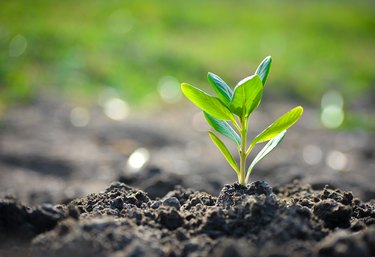
Arbor Day is the granddaddy of celebrations honoring our planet Earth. It was started in 1872 by the Nebraska State Board of Agriculture's Julius Sterling Morton when he recognized that his state's tree population was declining. He put Arbor Day into law to commemorate Earth's need for trees and what we can do to repopulate them.
Earth Day, celebrated on April 22 each year, was created in part as a response to Rachel Carson's book entitled "Silent Spring," published in 1962. It pointed out all the destruction humans have wrought on Earth, from air pollution to toxic water, and aimed to correct these environmental problems.
Video of the Day
Video of the Day
Earth Day vs. Arbor Day
The difference between Earth Day and Arbor Day is that while Earth Day recognizes humankind's negligence regarding the environment and aims to take steps to correct the imbalance, Arbor Day, while similar in purpose, is one day dedicated to the planting of trees, which in turn lowers the carbon footprint. It is celebrated on April 30. However, some states recognize the date but celebrate in conjunction with the planting schedule for their hardiness zone.
Oil spills, air and water pollution and student activism prompted Senator Gaylord Nelson into action in 1970, and he recruited college students to inspire Americans in their effort to halt the destruction of our environment. Such was the purpose of Earth Day. Recycling, walking instead of driving, eliminating abundant use of plastic and carrying reusable grocery bags made of natural fiber were all the result of Earth Day and the awareness it promotes.
The Meaning of Arbor Day
An arbor is a grove of trees, hence the name "Arbor Day." The celebration focuses on trees and their purpose in maintaining a low carbon footprint and how necessary they are in providing us with clean air. Communities gather to hear lectures on trees, bees, horticulture advancements and free tree giveaways, and it involves every member of the community, both young and old, in learning to appreciate the purpose of trees in our environment.
The advocacy starts with teaching children how to plant trees, the science of trees and how to choose trees that are of benefit to specific communities. Since each geographical area has specific hardiness zones and times of the year to plant trees, a custom orientation is necessary, but the result is learning what works in the community. Arbor Day isn't just one day; it's a philosophy that stretches throughout the year.
Different Days, Similar Purpose
Arbor Day's purpose is to inspire people to plant, nurture and celebrate trees, with a goal to make the world greener and healthier. When comparing Arbor Day and Earth Day, one must take into account the fact that both have an end goal of improving conditions on our planet. Arbor Day is community oriented, with projects focusing on making your lawn and yard more beautiful and attractive to wildlife and informing large corporations of the necessity of clean air and how replanting our forests can benefit the nation.
Earth Day expands on the philosophy of Arbor Day and is now a worldwide project with aims to protect the rain forests and to understand and accept climate change. It is the largest secular observance in the world. Planting a tree on Earth Day reinforces the purpose of Arbor Day and how the two are purposefully joined.